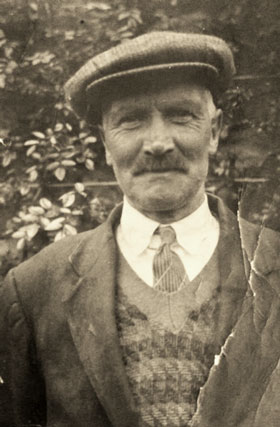Private John Hogg

John Hogg was born on 12 December 1881 at Leck, Cookstown, County Tyrone, the first of nine children of scutcher and carpenter Daniel Hogg and his wife Isabella (née McGee). By 1905 he was living in Stirling Street, Glasgow, and employed as an oil works labourer. On 8 April that year he married Elizabeth Jane McGarry at Milton Parish Church, Glasgow. Soon after, they returned to Cookstown. They had at least eight children over the next sixteen years. By the time of the 1911 Census they were living in Coagh Street, Cookstown, John working as a labourer.
Hogg enlisted in the North Irish Horse at Cookstown on 2 September 1914 (No.1098), with his brother James Hogg. Another brother, William, was already serving in France with the 2nd Battalion, Royal Inniskilling Fusiliers.
On 11 September 1914 the Northern Whig reported the following exchange at the Cookstown hearing of the voters' list revisions:
John Hogg, Factory Square, was objected to.
His wife swore to the succession from a house in Coagh Street to Factory Square. She was at her mother's a week, but her husband was in the house.
Mr. Harbison – Where is he now?
Mrs. Hogg – On the North Irish Horse.
Mr. Houston – Is that the objection to him? (Laughter.)
Mr. Harbison – Oh, no. (Laughter.)
The vote was allowed.
On 1 May 1915 Hogg embarked for France with D Squadron, which at the time was serving as divisional cavalry to the 51st Division.
On 11 September 1915 The Mid-Ulster Mail reported that:
Mrs. Hogg, Millburn Square, Cookstown, has received a letter from her husband, Trooper John Hogg, who is on the North Irish Horse. He says he is in splendid form, being in a nice locality since being released from the trenches three weeks ago. His Squadron were in a trench 180 yards from enemy, but in some places as near as 50 yards. The Huns are very attentive, especially at meal-times, keeping shrapnel bursting around. A sniper also gave them a lot of trouble, but did not succeed in catching any of them napping. His heaviest duty is at the sap head, the strict watch necessary being a great strain. The Germans would be liable to creep up and cut the wire entanglements or defences if they were not watched. In addition to periodical shelling with "coal boxes," the German attentions to the form of putting up notice-boards giving certain items of news. They were usually replied to from the rifles. The weather is splendid, but he keeps hoping that the war will soon end.
In May 1916 D Squadron came together with A and E Squadrons to form the 1st North Irish Horse Regiment, serving as corps cavalry to VII, XIX, then V Corps.
On 24 July 1916 Hogg faced a court martial at Pommera charged with being drunk while on active service, and escaping confinement. Initially awarded 9 months' hard labour, his sentence was later commuted to 3 months' Field Punishment No.1.
Hogg remained with the 1st North Irish Horse Regiment until 8 or 9 November 1917, when he was transferred to the Labour Corps (No.464896). He remained with the Labour Corps until the end of the war. On 11 March 1919 he was demobilised and transferred to Class Z, Army Reserve. He was granted a pension due to 'sciatica and myalgia', which were attributed to his military service.
At some point after the war Hogg and his family moved to Antrim, where they occupied one of the ex-servicemen's cottages on the Belfast Road. By 1944 he was working as a gardener and living at Pacific Avenue in Belfast. He died at the Royal Victoria Hospital, Belfast, on 21 October 1959, following an accident in which he was knocked down by a van. He was buried in St Andrew's Church of Ireland churchyard in Ardtrea, County Tyrone.

Belfast Telegraph, 29 October 1959
Image of John Hogg sourced from Ancestry.com Public Member Trees - contributor Allison Steele Perez. Some of the information about Hogg's life after the war provided by Nigel Henderson, Researcher at History Hub Ulster.
